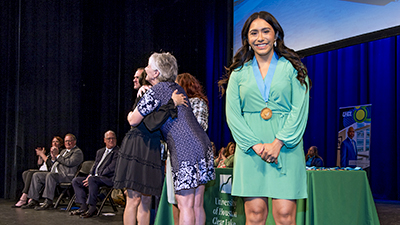Hispanic Heritage Month: Books by Latinx authors to add to your reading list
Great books have the power to transport readers into different worlds, inspire them, and teach them unforgettable lessons about themselves, their community and the world. To inspire readers to read works by Latin or Hispanic authors during Hispanic Heritage Month, University of Houston-Clear Lake’s Clinical Assistant Professor of Humanities and Women’s and Gender Studies Wanalee Romero, who teaches in the university’s Latinx and Latin American Studies program, has selected five of her favorite books and shares why she hopes others will enjoy them as well.
“Emplumada,” by Lorna Cervantes
“We’ll start with the title,” Romero said. “”Plumada’ means ‘flourish’ in Spanish, and Cervantes adds the ‘em,’ which evokes image of the plume with a feather on it. It’s a little bit of a made-up word. It indicates how ensconced she is in her writing, and that she and her poetry have wings.”
She said she chose this book of poetry because even though poetry can feel intimidating to some, this book makes it accessible. “If you don’t read often, it’s easy to read a one-page poem,” she said. “Cervantes’ poems are beautiful, easy to approach, and her conversational style makes for simple and straightforward reading.”
Cervantes approaches questions of different, complicated identities. “She’s a Mexican-American woman with close ties to her Native American background, although she was raised in the U.S.,” Romero said. “She talks about race and racial experiences for all minorities. I really like this collection.”
“Borderlands/La Frontera: The New Mestiza,” by Gloria Anzaldúa
“This is one of the foundational texts of Latino Studies, and the reason we recommend it is that it’s written in very everyday language, even with a little ‘Spanglish’ thrown in,” Romero said.
The book includes personal memoir, poetry, history and philosophy, and Anzaldúa breaks all the rules as a writer so that she can explain to the reader what it’s like to be from the Borderland.
“She explains that the ‘Borderland’ are any place where two cultures meet and clash,” Romero said. “There’s this vague place in the middle where different people and different ways of being coexist, and that’s the Borderland. She claims the title of ‘Border Dweller’ proudly, explaining that she has two identities and she’s trying to figure out how to reconcile them. It’s a messy thing that is hard to explain to others. I feel the same, and I think others will, too.”
“Caramelo,” by Sandra Cisneros
The book is a reference to the author’s grandmother’s “rebozo,” or lacy shawl that Mexican women wear over their shoulders. “This book is encapsulating—you can’t put it down,” Romero said. “It’s important because it explores the whole idea of borders and crossings. The narrator’s grandparents are still in Mexico, but she lives in Chicago and then goes to San Antonio. It’s interesting because of its perspective about her presence on both sides of the border.”
The protagonist is the only daughter in a large, Mexican-American family of boys, and she narrates the story, touching on gender, politics in families, privileges afforded to men over women, ideas about nationality and ethnicity.
“A lot of people have read Cisneros’ book, ‘The House on Mango Street,’” Romero said. “But this book is also very accessible and just gorgeous.”
“The Brief Wondrous Life of Oscar Wao,” by Junot Díaz
Díaz, a Dominican author, won the Pulitzer Prize for Fiction in 2008 for this novel. “This book takes place between New Jersey and the Dominican Republic, and explores the history of Dominicans in the U.S.,” Romero said. “It’s a brilliant narrative centered on Oscar Wao, who’s completely immersed in ‘nerd’ culture. There are references to video games, sci fi, Tolkien, and comic books throughout. It’s also heavily annotated by the narrator, who’s also one of the characters, but the footnotes are hilarious. The novel is a chronicle with moments of tragedy, but it’s written as a comedy.”
Romero added that most of the characters were Afro-Latino, a culture not explored enough in Latino literature. “That is another of many reasons to recommend this book,” she said.
“Mariposas: A Modern Anthology of Queer Latino Poetry,” by Emanuel Xavier
The word “mariposa” in Spanish means “butterfly,” but Romero explained that it’s also Latino slang for “gay” or “queer.”
This is a poetry collection written by Latinos from different backgrounds who identify as LGBTQ. “Every poem is from a different person who is expressing a different point of view culturally — Mexican, Caribbean, etc.,” Romero said. “What I find attractive about it is that it’s fresh and new, and not all the poets are well established. It’s exciting to know this is some poets’ first step. All the works are approachable.”
Visit the newsroom each week to keep up with our series of stories exploring topics related to Hispanic Heritage Month.
Learn more online about UHCL's history as a Hispanic-Serving Institution. Celebrate Hispanic Heritage Month by participating in a variety of events offered by the LLAS program, the Office of Student Diversity, Equity and Inclusion, the Bayou Theater and the Art Gallery.







